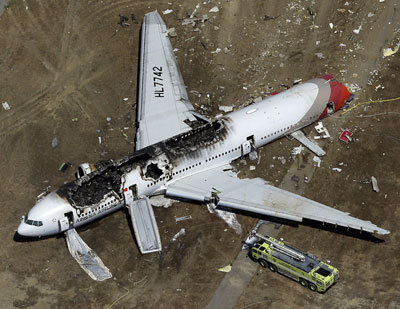 Washington
Washington: The pilot of an Asiana Airlines jet that crashed in San Francisco this year told investigators after the accident that he had been "very concerned" about landing without help from an airport navigation system that was out of order.
Capt. Lee Kang Kuk, who was highly experienced in a Boeing 747 but was transitioning to flying a 777, told the National Transportation Safety Board that he found it "very stressful, very difficult" to land without the glideslope indicator that helps pilots determine whether the plane is too high or too low during approach.
"Asked whether he was concerned about his ability to perform the visual approach while piloting Asiana Flight 214, he said 'very concerned, yea,'" the safety board revealed at a hearing on Wednesday on its investigation into the July 6 crash that killed three people and injured more than 180 others.
The jet struck a sea wall and broke apart on the runway following a missed approach.
The navigation aid that syncs up with aircraft instruments was out of service while the Federal Aviation Administration made runway safety improvements. But a second, visual lighting system was operable at the time of the daytime crash and the weather was clear.
The safety board investigation is focusing on whether pilots have become overly reliant on automation to fly commercial planes, and whether basic manual flying skills have eroded.
Investigators have also focused on the pilot understanding - or misunderstanding - of the plane's auto-thrust system, which controls aircraft power.
Some of the crew of the Asiana flight from Seoul told investigators the auto thrust was always engaged.
But the safety board has said that system was not engaged, and the jet descended in altitude faster than it should have, and had a slower forward speed than intended.
The combination put the plane into a perilous situation in the final minute of flight.
The relief first officer, Bong Dongwon, who was sitting behind Lee and instructor pilot Lee Jungmin, said he observed the fast descent - or sink rate - and called out the excessive sink rate "more than four times."
Bong told investigators the pilot appeared to be correcting the "sink rate" and did not advise further changes.
But its speed was declining at about the same time. The plane was flying at 170 knots 73 seconds before impact, dropped below the target speed for landing of 137 knots at roughly 38 seconds before impact, and plummeted as low as 103 knots just seconds before the plane's front landing gear and tail hit the sea wall at the end of the runway.
The crew made its first reference to the plane's speed problem just seven seconds before the crash.
The pilot called out a "go around" -- a command to abort the landing -- three seconds before impact.
Boeing's former chief pilot for the B777 program said automated systems are intended to help pilots, but that they still need to exercise diligence.
"We accept the fact that pilots, as all humans, make errors," he said. Automation is intended "as a tool to aid the pilot, not replace the pilot," he said.
Information released at Wednesday's hearing also showed investigators are concerned about the role Korean and airline culture played in the crash.
Bong said the crew practiced "cockpit resource management," training that encourages subordinates to speak up about safety concerns to other crew members, despite their senior rank, experience or seniority.
But when Lee -- who was considered a student pilot in the 777 -- was asked whether he had contemplated an aborted landing as the plane descended, he said it was a "very hard" decision to make, given the deference shown to superiors in Korean culture.
By the time Lee pushed the throttle forward just seconds before impact, he discovered his instructor had already done so.
Three passengers died in the accident -- two in the crash and a third on the ground when hit by a rescue truck responding to the scene.
The accident was the first fatal commercial airline crash in the United States since February 2009.
Crash survivor Ben Levy told CNN he was forfeiting an opportunity to watch the proceedings.
"I think something that I've done quickly after this plane crash has been to focus on work and family and things that matter to me," Levy said. "I'm extremely happy that something is being done to get to the bottom of what happened that day because it should not have happened." #Source: The CNN
 Washington: The pilot of an Asiana Airlines jet that crashed in San Francisco this year told investigators after the accident that he had been "very concerned" about landing without help from an airport navigation system that was out of order.
Washington: The pilot of an Asiana Airlines jet that crashed in San Francisco this year told investigators after the accident that he had been "very concerned" about landing without help from an airport navigation system that was out of order.